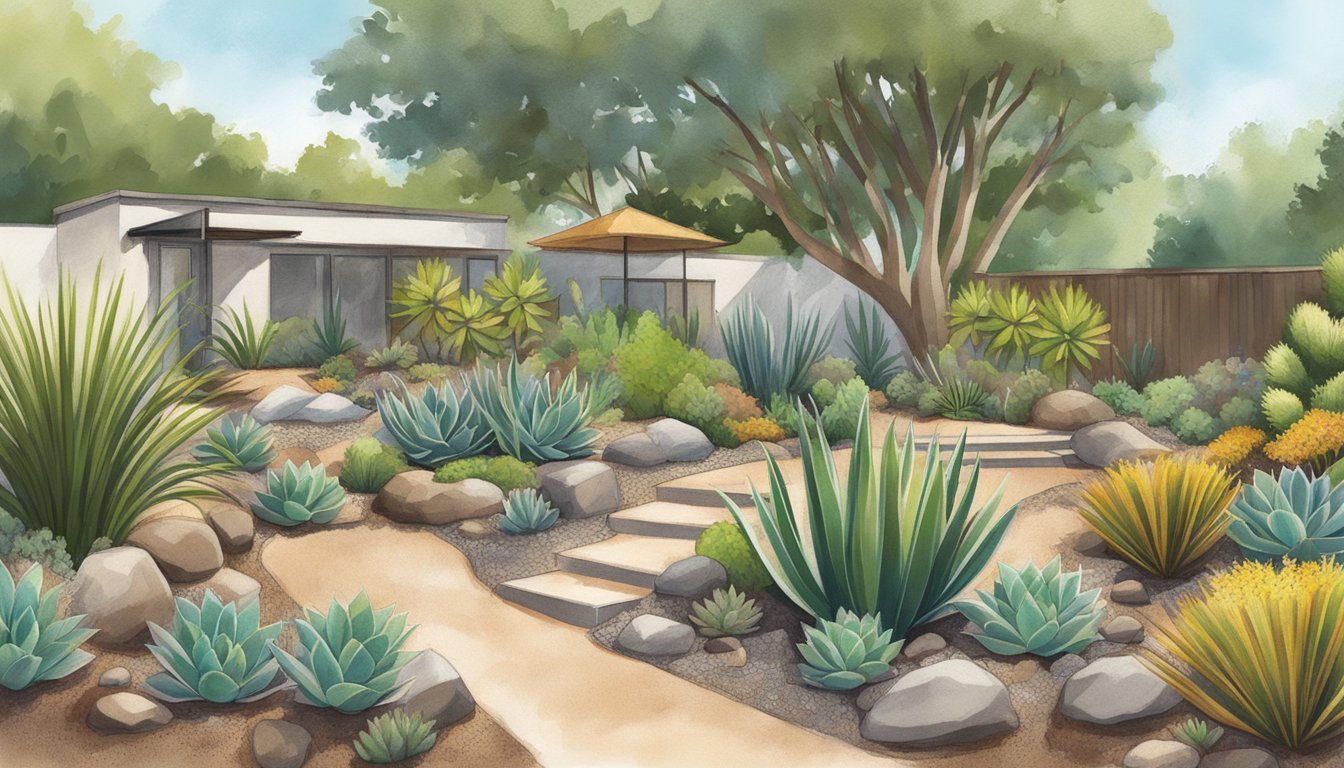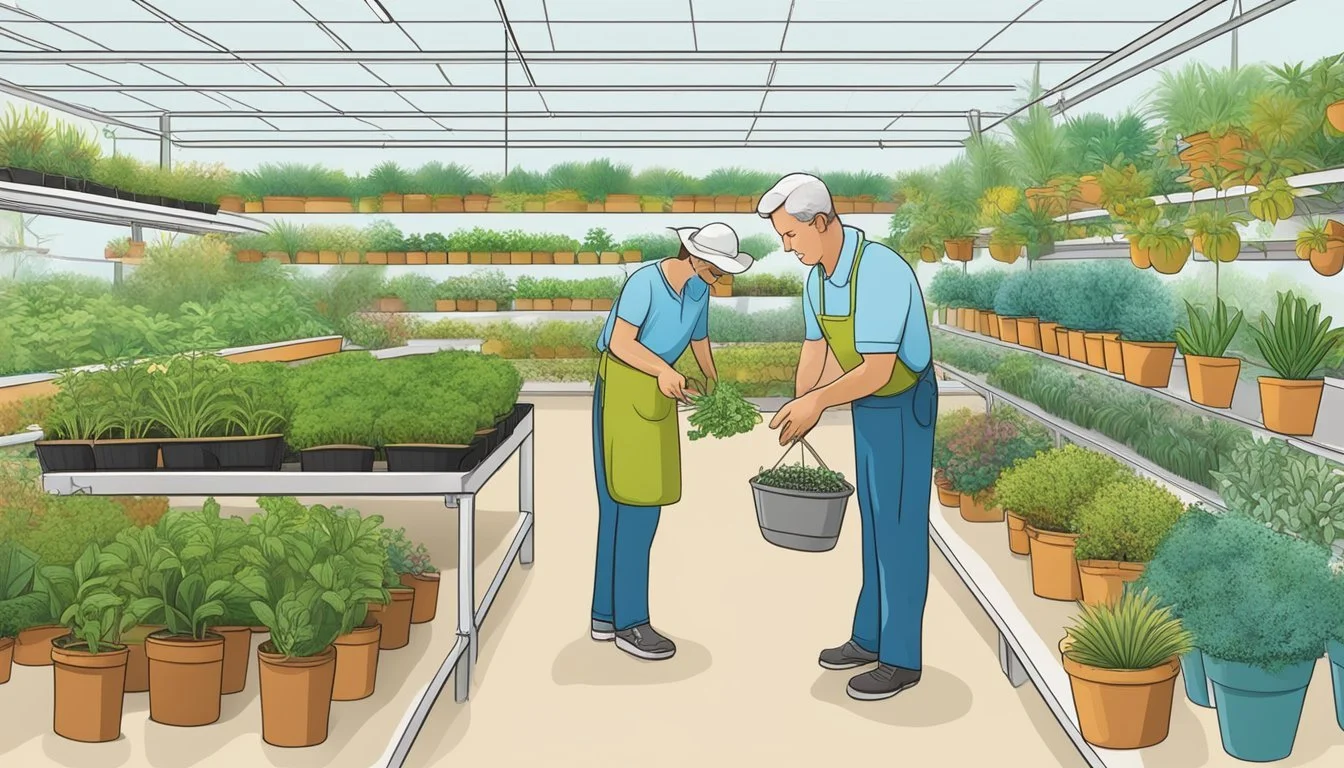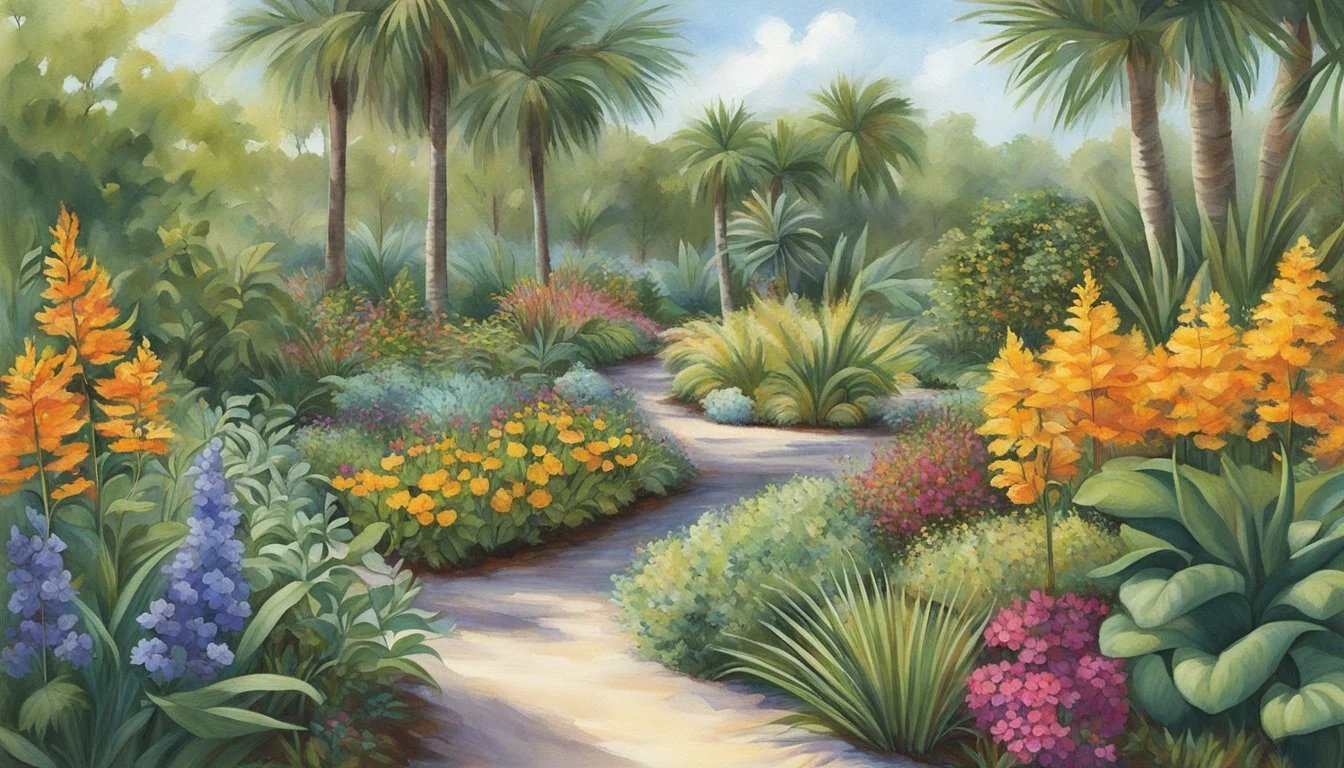Drought-Tolerant Plants in Florida
Thriving Flora for Arid Climates
Florida's unique climate presents a variety of challenges for gardening and landscaping, particularly when it comes to irrigation and water conservation. With its extended periods of heat and sometimes unpredictable rainfall, gardeners and landscapers within the state have increasingly turned to drought-tolerant plants as a sustainable solution. These plants have adapted to survive in conditions with limited water, making them ideal for the Floridian environment.
By integrating drought-tolerant plants into their gardens, Florida residents can maintain beautiful and resilient landscapes that require less water and reduce the need for artificial irrigation. This not only conserves the valuable water resource but also supports native wildlife and helps maintain the ecological balance. Among the diverse species of drought-tolerant plants, certain perennials and shrubs thrive in Florida's climate, providing a functional and aesthetic value to the local flora.
Furthermore, these plants often demand less maintenance and are typically more resistant to pests and diseases, which can offer gardeners both convenience and cost savings. In light of Florida's environmental conditions, drought-tolerant plants are not just a trend; they represent a practical approach to gardening that aligns with the state's natural landscape and climatic challenges.
Understanding Drought in Florida
Drought in Florida varies significantly due to its unique climate and weather patterns. The state's water restrictions and usage are directly influenced by these conditions, requiring adaptation and strategic planning for resource management.
Climate and Weather Patterns
Florida's climate, known as humid subtropical, is characterized by high temperatures and humidity. The state experiences distinct wet and dry seasons, with the latter typically running from October through May. During the dry season, the Sunshine State sees significantly less rain, leading to periods of drought. These climatic factors, coupled with occasional events like El Niño, can exacerbate drought conditions, making water conservation a critical issue.
Water Restrictions and Usage
In response to the varying levels of rainfall and the need to maintain water reserves, Florida implements water restrictions which can affect residents and businesses alike. These restrictions often dictate the days and times when watering lawns or washing cars is permitted. Moreover, water usage policies, aiming to reduce consumption, are enforced during drought periods to ensure a sustainable water supply for the state’s growing population and natural ecosystems.
Principles of Drought-Tolerant Landscaping
Incorporating drought-tolerant landscaping principles not only conserves water but also supports local ecosystems. These practices are essential for creating Florida-friendly landscaping that is both sustainable and resilient.
Importance of Native Plant Species
Native plant species are central to drought-tolerant landscaping in Florida. They have evolved to thrive in the local climate and soil conditions, requiring less water and maintenance than non-native plants. For instance, the bush daisy and coontie are well-adapted to withstand dry spells common in Florida’s climate. By prioritizing these plant species, homeowners can reduce their landscape’s water consumption and enjoy a flourishing garden with minimal effort.
Landscape Design for Water Conservation
Effective landscape design is a key factor in water conservation. Zones should be created within the garden to group plants with similar water needs, limiting unnecessary water usage. Use of mulch can also retain soil moisture and reduce evaporation. Designing with drought-tolerant plants like lavender and the beach dune sunflower not only saves water but also provides year-round aesthetic value. Raised beds and sloping landscapes can be applied strategically to manage water flow and distribution, ensuring that every drop of water is used efficiently.
Benefits to Ecosystems
Drought-tolerant landscapes offer substantial benefits to local ecosystems. By choosing plants such as the purple coneflower and native grasses, landscapes become a habitat for local wildlife like pollinators and birds. This boosts biodiversity and helps maintain a balance in the ecosystem. Furthermore, by reducing the need for water and chemical fertilizers, these landscapes promote a healthier environment, with less runoff polluting Florida's waterways.
Selecting Drought-Tolerant Plants
Creating a Florida-friendly yard that thrives during dry spells hinges on selecting the right species of drought-tolerant plants. They should be well-adapted to local climate conditions and able to flourish with minimal water once established.
Trees and Shrubs
When integrating trees and shrubs into a Florida landscape, it's crucial to choose species that can endure prolonged dry periods. An example is the Buttonwood (Conocarpus erectus), a native plant known for its resilience to harsh conditions. Additionally, the Dwarf Saltbush is an exceptional choice for its adaptability and aesthetic appeal.
Perennials and Annuals
For color and variety, perennials and annuals offer a palette that remains vibrant even in dry conditions. Plants like the Dune Sunflower present a hardy option that adds a splash of yellow to your garden. Annuals, such as the variety described in the Florida-Friendly Landscaping™ Guide, also present options for gardeners looking for less permanent, yet drought-tolerant additions.
Grasses and Groundcovers
Choosing the right grass and ground cover can reduce the need for frequent watering. Selections like the Dwarf Saltbush can cover expansive areas with a blanket of drought-resistant foliage, providing a lush carpet that requires minimal maintenance.
Cacti and Succulents
Finally, for those barren areas where other plants might struggle, incorporating cacti and succulents can be a smart move. These plants inherently store water, making them perfect for drought-prone environments. The Floridian climate is suitable for these species, offering an aesthetically pleasing and practical option for water conservation in your garden.
Care and Maintenance of Drought-Resistant Flora
Drought-resistant plants, adapted to thrive in Florida's challenging climate, demand attention to soil and water management as well as sunlight and temperature conditions to flourish with minimal care.
Soil and Water Requirements
For drought-resistant flora, well-draining soil is paramount. These plants require a soil composition that allows excess water to escape, avoiding root rot and other moisture-related diseases. One must ensure that the ground is loose and permeable. When it comes to watering, the concept is 'less is more.' While establishing plants, regular watering helps them develop a deep root system, but once established, they need minimal watering. Such low-care requirements make plants like the Blanket Flower a desirable choice for Florida gardens, as they naturally adapt to the local conditions.
Sunlight and Temperature Considerations
Drought-resistant plants typically thrive in climates that simulate their native environment. Full sun exposure, meaning at least six hours of direct sunlight daily, is crucial for the majority of these species. However, some plants can withstand or even prefer partial sun, which involves direct sunlight for just a portion of the day, often the cooler morning hours. Temperature-wise, these plants are impressionable; able to tolerate high temperatures and typically heat-loving. The Firebush, for instance, flourishes in full sun and can handle Florida's intense heat, which aids in its vibrant growth and attractiveness to pollinators.
Popular Drought-Tolerant Plants for Florida Gardens
Florida's climate demands garden plants that can withstand dry conditions. This section provides garden enthusiasts with a selection of drought-tolerant plants suited for Florida's unique environment, focusing on their visual appeal and ecological benefits.
Flowering Plants and Attractors of Wildlife
Gaillardia pulchella (Indian Blanket): An easy-to-grow plant that showcases vibrant red and yellow flowers. It's a favorite among butterflies for its nectar.
Helianthus debilis (Beach Sunflower): A perennial groundcover that not only offers bright yellow blooms but also serves as an important food source for pollinators.
These florae not only embellish the garden with their blooms but also play a vital role in supporting local wildlife, including hummingbirds and pollinators.
Shade and Ornamental Trees
Conocarpus erectus (Buttonwood): This tree is adaptable to various lighting conditions, thriving in full sun for a silver foliage display. It grows to be 10 to 20 feet and provides considerable shade.
Buttonwoods offer more than just shade; their distinct silver foliage brings a unique aesthetic to any landscape.
Utility and Protective Vegetation
Grasses: Species like Cordgrass and Muhly grass exhibit high drought tolerance, perfect for Florida landscapes. They offer erosion control while requiring minimal maintenance.
Utilitarian plants like these grasses are essential for creating sustainable, low-water-use areas in Florida gardens. They provide protective ground cover and resilience against fluctuating weather conditions.
Environmental Impact and Conservation
Incorporating drought-tolerant plants into Florida landscapes significantly aids in water conservation efforts and bolsters local ecosystems by providing habitats and food for various species of wildlife, including butterflies, hummingbirds, and other pollinators.
Water Conservation Best Practices
When designing a drought-resistant garden, it is important to prioritize the use of native plants as they are adapted to Florida's climate and require minimal irrigation. Central Florida's Zone 9, for instance, hosts a range of drought-tolerant plants that flourish with less water, helping to mitigate the need for frequent watering despite local water restrictions. Strategically planning a landscape to group plants with similar water needs together can also maximize efficiency and minimize resource waste.
Group plants with similar needs: Place those requiring more water in the same area to concentrate irrigation efforts.
Mulch to retain moisture: Applying mulch reduces evaporation and keeps roots cooler.
Rainwater harvesting: Utilize rain barrels to collect water for irrigation during dry spells.
Supporting Local Wildlife and Pollinators
Native plants have evolved in conjunction with Florida's native wildlife, providing the perfect sources of nourishment and shelter. For example, Coreopsis, Florida's state wildflower, attracts a multitude of pollinators like bees and butterflies with its vibrant blooms. Planting a selection of these drought-tolerant natives encourages a diverse and balanced ecosystem where pollinators can thrive, an essential factor as they play a crucial role in the reproduction of many plants.
Provide a variety of plants: A mix of flowering plants will ensure blooms through different seasons, providing continuous food.
Create habitats: Incorporate elements such as bird baths or butterfly gardens to offer shelter and resources.
Planting and Growth Strategies
Effective planting and growth strategies for drought-tolerant plants in Florida hinge on understanding the specific needs for germination, propagation, and coping mechanisms during dry periods. A well-informed approach can ensure that these resilient species thrive in challenging conditions.
Germination and Propagation
For successful germination of drought-tolerant plants, it's essential to start with quality seeds that are adapted to Florida's climate. For example, the Firebush (Hamelia patens) seeds must be sown in well-draining soil and should not be overwatered, as this can cause fungal issues that inhibit growth. Cuttings from plants such as the Silver Buttonwood (Conocarpus erectus) can also be rooted during the warmer months, ensuring they establish themselves before any dry spells.
Coping with Dry Periods
During dry periods, care for drought-tolerant plants involves strategic watering and mulching to conserve moisture. Drought-resistant species like those suitable for Florida's climate are adapted to withstand water scarcity by slowing down their growth and reducing transpiration. Home gardeners are advised to water plants deeply but infrequently, promoting the development of strong, deep root systems. Mulching with organic materials can also help to retain soil moisture and reduce the need for frequent watering. Regular monitoring of soil moisture can prevent over-watering, which is as detrimental as under-watering.
Drought-Tolerant Plant Spotlight
This segment examines a selection of Florida's drought-resistant plants, focusing on specific species that maintain resilience in dry conditions. The qualities and utilities of these plants within a garden setting are highlighted.
Lavender
Lavender (Lavandula spp.) is celebrated for its fragrant leaves and flowers. It thrives in Florida's sandy soils that mimic its native Mediterranean habitat, requiring minimal water once established. The plant's silvery foliage and vibrant purple blooms not only add a splash of color but also attract beneficial pollinators to the garden. Lavender is notably heat-tolerant and can survive in full sun, embodying the qualities of an ideal drought-tolerant plant for Floridian landscapes.
Here are additional drought-tolerant plants that are commonly found in Florida:
Agave (Agave spp.): With its striking rosette of leaves, agave is a sculptural plant that is well-suited to Florida's dry conditions.
Firebush (Hamelia patens): This native shrub offers vibrant red-orange flowers and is beloved by hummingbirds and butterflies.
Saw Palmetto (Serenoa repens): A fixture in Florida's natural landscape, saw palmetto is highly adaptable and tolerant of drought.
Buttonwood (Conocarpus erectus): Often used in coastal landscapes, buttonwood is recognized for its tolerance to both drought and salt.
Aloe (Aloe spp.): Known for its medicinal properties, aloe is another succulent that conserves water in its thick, fleshy leaves.
Beautyberry (Callicarpa americana): With its distinct purple berries, beautyberry is a native plant that requires minimal irrigation.
Longleaf Pine (Pinus palustris): Also known as yellow pine, this tree species is adapted to the region's dry, sandy soils.
Coontie (Zamia integrifolia): As Florida's only native cycad, coontie is a low-maintenance plant that once populated the ancient landscape.
Yucca (Yucca spp.): This plant's sword-shaped leaves and tall flower spikes give it a dramatic presence in dry gardens.
Bay Cedar (Suriana maritima): Valued for its durability, bay cedar thrives in dry, sandy conditions and can also withstand salty coastal winds.
Texas Sage (Leucophyllum frutescens): This flowering shrub is praised for its ability to flourish in drought with minimal care.
Sea Grape (Coccoloba uvifera): Although often associated with coastal areas, sea grape is equally adept at handling dry periods.
Each of these species is distinctive, not only in appearance but also in its ability to prosper in Florida's challenging climate with little need for frequent watering. They are excellent choices for gardeners seeking to cultivate an environmentally conscious and water-wise landscape.
Designing a Low-Cost, Low-Maintenance Landscape
Creating a landscape that is both low in cost and maintenance requires strategic planning and the selection of plants that are well-adapted to the Florida climate. Such a landscape can offer both financial savings and ease of care.
Cost-effective Plant Choices
In Florida, choosing drought-tolerant plants such as Crown of Thorns or Muhly Grass can lead to a significant reduction in water usage and maintenance costs. Plants like the Agave and the Desert Rose serve well as specimens with their distinctive forms that add allure with minimal upkeep. An approach that focuses on larger leaves and persistent structures over fleeting blooms can prove both economical and visually appealing.
Foundation Plants: Coontie, Simpson's stopper
Specimens: Agave, Frangipani
Groundcover: Ice plant
Accents: Crown of Thorns, Muhly Grass
Simple Care Techniques
The essence of low-maintenance landscaping lies in the simplicity of care. Techniques such as mulching help conserve soil moisture and reduce weed growth. Integrating an efficient irrigation system, potentially one that leverages rainwater, can create a landscape that thrives with minimal intervention. The sustainable selection of foliage with color and texture minimizes the need for regular maintenance without compromising on the landscape's design.
Irrigation: Consider drip irrigation or soaker hoses for targeted watering.
Mulching: Use organic mulch to enrich the soil and suppress weeds.
Plant Placement: Situate plants in microclimates within the landscape where they will naturally flourish.
Encouraging Biodiversity with Florida Plants
Florida's native flora provides incredible opportunities to foster biodiversity, particularly through selecting plants that support pollinators and create habitats for various wildlife. The state's unique ecosystem benefits from these plants, which are well-adapted to its climate.
Supporting Various Pollinators
Butterflies and hummingbirds are essential pollinators that contribute to the health and reproduction of many plants. Native saw palmetto and acacia with their attractive blossoms are particularly effective at drawing a diverse range of pollinators. The feathery foliage of acacia not only adds visual interest but also serves as a critical food source for butterfly larvae. Similarly, ornamental grasses can also provide nectar and are vital in the life cycle of some butterfly species.
Butterflies: Favor plants like wildflowers and native milkweeds.
Hummingbirds: Drawn to tubular flowers in bright shades of red and pink.
Creating Habitats for Wildlife
Creating robust ecosystems within a garden involves more than just catering to pollinators. It equals providing homes and resources for a variety of wildlife. The saw palmetto serves as an excellent shelter for birds, and its berries are a valuable food source. In addition, ornamental grasses can supply cover for small animals and insects throughout the year.
Shelter: Saw palmetto and dense shrubberies provide safe places for wildlife.
Food Supply: Berry-producing plants and seed-filled grasses offer sustenance.
Resources and Further Reading
For enthusiasts wanting to explore drought-tolerant plants suitable for Florida's distinct climate, a range of resources are available.
Websites:
Florida Native Plants: A guide listing native plants adapted to dry conditions, emphasizing the importance of sourcing from local seed sources to protect natural ecosystems.
Pond Informer: Details 20 drought-tolerant plants, with an illustrative example being the silver buttonwood, a shrub native to regions including southern Florida.
Treehugger: Provides insights into a variety of Florida native plants that excel in both heat and humidity, offering an updated list as a resource for gardeners.
Academic and Extension Services:
University of Florida: Offers extensive information on Super Drought-Tolerant Plants, including species like acacia trees and rosemary.
IFAS Orange County Extension: An informative article discussing various drought-tolerant plants suitable for Central Florida's Zone 9, accompanied by detailed plant information through the Florida-Friendly Landscaping™ Guide.
Books (Titles in italics):
Dryland Gardening: Plants that Survive and Thrive in Tough Conditions by Jennifer Bennett
The Drought-Defying California Garden: 230 Native Plants for a Lush, Low-Water Landscape by Greg Rubin and Lucy Warren
Gardeners and landscapers can enrich their knowledge about creating sustainable, water-conserving gardens by consulting these materials, ensuring that their green spaces remain vibrant and eco-friendly.
Frequently Asked Questions
In this section, we address common inquiries regarding the selection and cultivation of drought-tolerant plants that are well-suited to Florida's unique climate.
What are examples of low-maintenance, drought-tolerant plants suitable for Florida's climate?
Low-maintenance, drought-tolerant plants for Florida include species like Coontie and Muhly Grass, which thrive in the state's climate with minimal watering once established.
Which native Florida plants exhibit the best drought tolerance for landscaping?
Native Florida plants such as Saw Palmetto and Gallberry are both attractive and highly drought-tolerant, making them excellent choices for sustainable landscaping.
Can you list drought-tolerant flowering plants that thrive in Florida's full sun conditions?
Flowering plants like Beach Sunflower and Blanket Flower not only withstand full sun but also bring vibrant colors to a Florida garden without needing frequent watering.
What shrubs are recommended for drought resistance in Florida's zone 9?
In Florida's zone 9, shrubs such as Wax Myrtle and Firebush are recommended for their exceptional ability to withstand dry spells.
What are the ideal drought-tolerant plants for container gardening in Florida?
For container gardening, drought-tolerant plants like Rosemary and Lantana adapt well to containers and are well-suited to Florida's climate, requiring less frequent watering.
How do you design a low-maintenance, drought-tolerant landscape in Central Florida?
Designing a low-maintenance, drought-tolerant landscape in Central Florida involves selecting plants with low water requirements, such as Purple Coneflower and Coreopsis, and arranging them in a way that maximizes water retention and reduces the need for irrigation.







